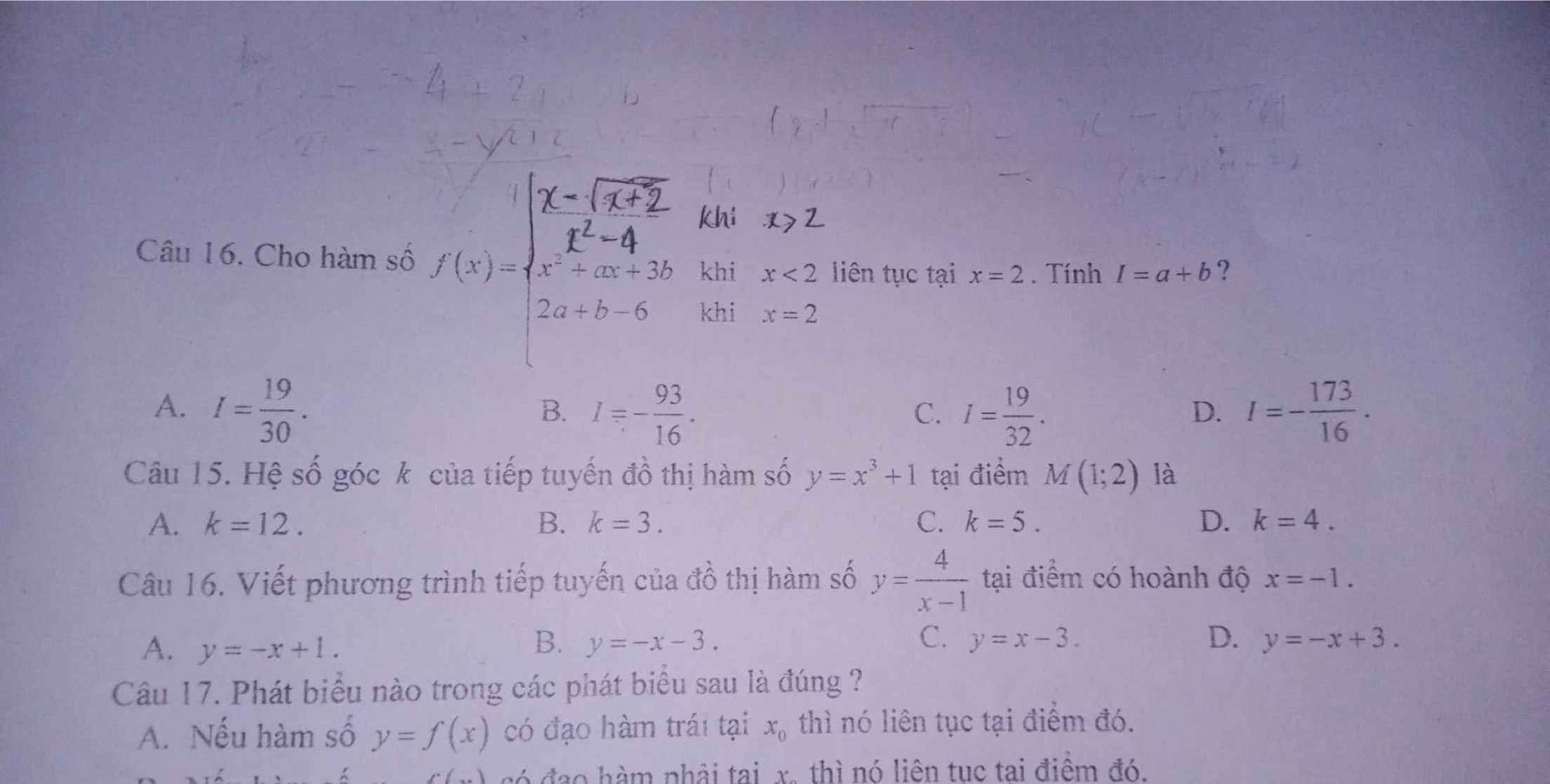
Hãy nhập câu hỏi của bạn vào đây, nếu là tài khoản VIP, bạn sẽ được ưu tiên trả lời.


Lời giải:
Đẳng thức \(\Leftrightarrow \frac{n!}{(n-2)!}-\frac{(n+1)!}{(n-1)!2!}=5\)
\(\Leftrightarrow n(n-1)-\frac{n(n+1)}{2}=5\)
\(\Leftrightarrow n^2-3n-10=0\Leftrightarrow (n-5)(n+2)=0\)
Vì $n$ tự nhiên nên $n=5$. Đáp án B.

Bạn lưu ý chuyển bài toán vào đúng mục xác suất trong toán 11, không phải hàm số lượng giác.
Lời giải:
Gọi số có 3 chữ số phân biệt được lập từ $0,1,2,3$ là $\overline{a_1a_2a_3}$.
$A$ là tập hợp các số $\overline{a_1a_2a_3}$ mà $a_1$ có thể bằng $0,1,2,3$
$B$ là tập hợp các số $\overline{a_1a_2a_3}$ mà $a_1\neq 0$ (chính là số thỏa đề)
$C$ là tập các số $\overline{a_1a_2a_3}$ mà $a_1=0$
Tại tập $A$ thì mỗi số $0,1,2,3$ xuất hiện $18$ lần ở 3 vị trí hàng chục, trăm, đơn vị.
Tổng chữ số tập $A$:
$\frac{1}{3}.18(0+1+2+3)(10^2+10+1)=3996$
Tổng chữ số tập $C$ là:
$012+021+013+031+023+032=132$
Tồng các chữ số tập $B$ là:
$3996-132=3864$
Tổng các chữ số tập $B$:
$11988-132=11856$

Đk:\(tanx\ne\pm1;tanx\ne0;sin\left(x+\dfrac{\pi}{4}\right)\ne0\)
Pt \(\Leftrightarrow\dfrac{\dfrac{sinx}{cosx}}{1-\dfrac{sin^2x}{cos^2x}}=\dfrac{1}{2}.cotx\left(x+\dfrac{\pi}{4}\right)\)
\(\Leftrightarrow\dfrac{sinx.cosx}{cos^2x-sin^2x}=\dfrac{1}{2}.cotx\left(x+\dfrac{\pi}{4}\right)\)
\(\Leftrightarrow\dfrac{\dfrac{1}{2}.sin2x}{cos2x}=\dfrac{1}{2}.tan\left(\dfrac{\pi}{4}-x\right)\)
\(\Leftrightarrow tan2x=tan\left(\dfrac{\pi}{4}-x\right)\)
\(\Leftrightarrow2x=\dfrac{\pi}{4}-x+k\pi\), k nguyên
\(\Leftrightarrow x=\dfrac{\pi}{12}+k.\dfrac{\pi}{3}\)
Ý D

Đặt \(x-\dfrac{\pi}{4}=t\Rightarrow x=t+\dfrac{\pi}{4}\Rightarrow3x-\dfrac{\pi}{4}=3\left(t+\dfrac{\pi}{4}\right)-\dfrac{\pi}{4}=3t+\dfrac{\pi}{2}\)
\(\Rightarrow sin\left(3x-\dfrac{\pi}{4}\right)=sin\left(3t+\dfrac{\pi}{4}\right)=cos3t\)
Đồng thời: \(sin^4x+cos^4x=\left(sin^2x+cos^2x\right)^2-2sin^2x.cos^2x\)
\(=1-\dfrac{1}{2}sin^22x=1-\dfrac{1}{2}sin^2\left(2t+\dfrac{\pi}{2}\right)=1-\dfrac{1}{2}cos^22t\)
Nên pt trở thành:
\(1-\dfrac{1}{2}cos^22t+cost.cos3t-\dfrac{3}{2}=0\)
\(\Leftrightarrow-1-cos^22t+cos4t+cos2t=0\)
\(\Leftrightarrow-1-cos^22t+2cos^22t-1+cos2t=0\)
\(\Leftrightarrow cos^22t+cos2t-2=0\)
\(\Leftrightarrow\left[{}\begin{matrix}cos2t=1\\cos2t=-2\left(loại\right)\end{matrix}\right.\)
\(\Leftrightarrow2t=k2\pi\)
\(\Leftrightarrow t=k\pi\)
\(\Leftrightarrow x-\dfrac{\pi}{4}=k\pi\)
\(\Leftrightarrow x=\dfrac{\pi}{4}+k\pi\)


Ta có : \(f\left(2\right)=2a+b-6\)
\(\lim\limits_{x\rightarrow2^+}\dfrac{x-\sqrt{x+2}}{x^2-4}=\lim\limits_{x\rightarrow2^+}\dfrac{x^2-x-2}{\left(x-2\right)\left(x+2\right)\left(x+\sqrt{x+2}\right)}\)
\(=\lim\limits_{x\rightarrow2^+}\dfrac{x+1}{\left(x+2\right)\left(x+\sqrt{x+2}\right)}=\dfrac{3}{16}\)
\(\lim\limits_{x\rightarrow2^-}x^2+ax+3b=4+2a+3b\)
H/s liên tục tại điểm x = 2 \(\Leftrightarrow\dfrac{3}{16}=2a+3b+4=2a+b-6\)
Suy ra : \(a=\dfrac{179}{32};b=-5\) => t = a + b = 19/32 . Chọn C

\(sin\left(3x-\dfrac{\pi}{4}\right)=\dfrac{\sqrt{3}}{2}\)
\(\Leftrightarrow sin\left(3x-\dfrac{\pi}{4}\right)=sin\dfrac{\pi}{3}\)
\(\Leftrightarrow\left[{}\begin{matrix}3x-\dfrac{\pi}{4}=\dfrac{\pi}{3}+k2\pi\\3x-\dfrac{\pi}{4}=\pi-\dfrac{\pi}{3}+k2\pi\end{matrix}\right.\)
\(\Leftrightarrow\left[{}\begin{matrix}x=\dfrac{7\pi}{36}+\dfrac{k2\pi}{3}\\x=\dfrac{11\pi}{36}+\dfrac{k2\pi}{3}\end{matrix}\right.\)
\(\Rightarrow\) Nghiệm âm lớn nhất: \(x_1=\dfrac{11\pi}{36}-\dfrac{2\pi}{3}=-\dfrac{13\pi}{36}\)
Nghiệm dương bé nhất: \(x_2=\dfrac{7\pi}{36}\)
\(\Rightarrow x_1+x_2=-\dfrac{\pi}{6}\)










Có \(2!=2\) cách xếp 2 người nhóm 1 kề nhau
Có \(3!=6\) cách xếp 3 người nhóm 2 kề nhau
Coi 2 người nhóm 1 là 1 bó và 3 người nhóm 2 là 1 bó (chiếm 5 vị trí nên còn 2 vị trí trống trong 7 vị trí)
Chọn 2 vị trí trong 4 vị trí: \(A_4^2=12\) cách
Theo quy tắc nhân có: \(2.6.12=144\) cách